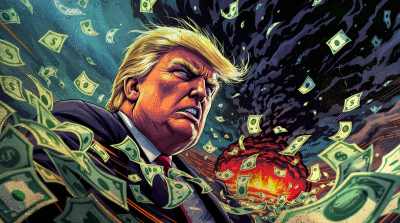
Trump’s Tariff Bomb: What’s the Problem?
President-elect Trump has campaigned on an “America First” platform and has signaled a strong protectionist trade policy, with tariffs at the center of his agenda, most notably high rates of tariffs targeting major trading partners such as China, Mexico, and Canada.
Specifically:
- An additional 10% tariff on imports from China (on top of existing tariffs)
- 25% tariffs on imports from Mexico and Canada
- 10-20% ‘universal tariffs’ on imports from other countries The goals of these policies are clear.
They are to protect American businesses and workers, reduce the trade deficit, and correct unfair practices by foreign companies.
However, questions have been raised among economists about the effectiveness of this policy. Will tariff bombs have the intended effect? Or do they have the opposite effect?
The Economics of Tariffs: Who Gains and Who Loses?
To understand the impact of tariff policies, it’s important to first understand the basic principles of tariffs. Tariffs are taxes imposed on imported goods, which have the effect of increasing the price paid by consumers.
Here’s an example. If a $100 smartphone made in China is subject to an additional 10% tariff, US consumers will pay $110 for it. This has two consequences
- the purchasing power of the US consumer decreases
- the relative price competitiveness of American-made products increases. If President-elect Trump is correct in his claims, this will cause consumers to choose American-made products over imports, which in turn will benefit American businesses and workers.
But the reality is not so simple.
The paradox of tariffs: unintended consequences
Let’s take a look at some of the problems economists point out with tariff policies.
- Raising consumer prices The price increases caused by tariffs are passed on to consumers. According to an analysis by the World Bank, Trump’s 10% universal tariff policy would increase consumer prices if implemented.
- Increased costs for businesses Tariffs apply not only to finished goods, but also to raw materials and intermediate goods. This increases the cost of production for US companies, especially those industries that rely on global supply chains.
- Risk of retaliatory tariffs International trade is not a one-way street. If the US imposes high tariffs, other countries are likely to respond with retaliatory tariffs. In fact, major trading partners such as China and the EU are already threatening retaliatory tariffs on US products.
- Slow economic growth Increased costs, reduced exports, and increased uncertainty due to tariffs could slow overall economic activity. The World Bank has estimated that Trump’s 10% universal tariff policy could reduce US GDP by up to 0.9% if implemented.
They are to protect American businesses and workers, reduce the trade deficit, and correct unfair practices by foreign companies.
- How neighboring countries are responding In response to President-elect Trump’s tariff threats, neighboring countries have responded as follows
- China: The Chinese government criticized Trump’s tariff threats as “completely contrary to facts and reality.” China is considering retaliatory tariffs and has expressed its willingness to negotiate trade deals with the U.S.3.
- Canada: The Canadian government has reacted strongly to Trump’s tariff threats. Ontario Premier Doug Ford warned that the tariffs would be “devastating to workers and jobs in both the U.S. and Canada.”18
- Mexico: The Mexican government has indicated that it will respond to U.S. tariff threats with retaliatory tariffs. “The response to one tariff will be another tariff,” said Mexican President Claudia Sheinbaum.
Conclusion: Tariff policy needs a cautious approach
President-elect Trump’s tariff policies may help protect some industries and reduce the trade deficit in the short term. But in the long term, they are likely to have a negative impact on the economy as a whole.
#TrumpTariffPolicy #Protectionism #AmericaFirst #TradeWar #ConsumerPriceIncrease #EconomicSlowdown #GlobalSupplyChain #RetaliatoryTariffs #InternationalTrade #ChinaTariffs #CanadaTariffs #MexicoTariffs #EconomicImpact #TradeDeficit #IndustryProtection #InternationalRelations




